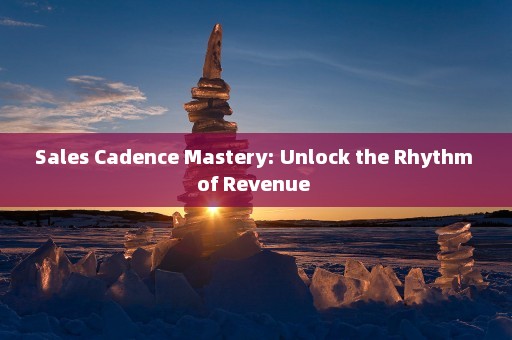Picture this: it's a bustling Monday morning, the air is thick with the hum of a busy sales floor. Phones are ringing off the hook, and the tap-tap-tap of keyboard strokes echoes like a symphony of productivity. I stand at the center of it all, a maestro conducting the intricate dance of sales cadence. In this world, timing is everything, and I'm about to share the secrets that will turn your sales team into a well-oiled, revenue-generating machine.

Understanding the Beat of Sales Cadence
As a seasoned sales specialist, I've seen firsthand how the right sales cadence can make or break a deal. It's not just about making calls or sending emails; it's about finding the perfect rhythm that resonates with your prospects. Over the years, I've honed my craft and gathered insights that will help you create a sales cadence that sets the tempo for success.
Setting the Stage: Foundations of a Solid Cadence
Before we dive into the specifics, let's establish the cornerstones of an effective sales cadence:
- Consistency: Like a metronome, your cadence must maintain a steady pace. Inconsistencies can lead to missed opportunities and confusion among prospects.
- Personalization: Tailoring your approach to each prospect's unique needs is crucial. A one-size-fits-all cadence is as ineffective as a musician playing the wrong notes.
- Relevance: Your messages must resonate with your audience. Understanding their pain points and speaking to them in their language is key.
- Adaptability: Just as a musician adjusts their tempo, a successful salesperson must be able to read the room and pivot their cadence as needed.
Measuring the Beat: Data-Driven Insights
Let's face it; intuition can only take us so far. To truly master the sales cadence, we need cold, hard data. Here are some key metrics to consider:
- Response Rates: Analyze how often your prospects engage with your outreach. If the numbers are low, it might be time to adjust your timing or messaging.
- Touch Frequency: Studies show that it takes an average of 8-12 touches to connect with a prospect. Find the balance between persistence and annoyance.
- Conversion Rates: Measuring how many prospects move down the sales funnel will give you a clear picture of your cadence's effectiveness.
Composing the Perfect Sales Cadence: A Step-by-Step Guide
Step 1: Identify Your Target Audience
Understanding your ideal customer is the first step in crafting a successful sales cadence. Create detailed buyer personas and tailor your messages to speak directly to their needs.
Step 2: Map Out Your Touchpoints
Plotting out your touchpoints in advance ensures a cohesive and strategic approach. Consider a mix of communication channels such as email, phone calls, and social media. Here's an example of a 5-touch cadence:
- Touch 1: Introduction Email - Offer value, provide a brief overview of your product, and set the stage for further conversation.
- Touch 2: Follow-up Call - Reach out 2-3 days after the initial email. Use this opportunity to build rapport and gather more information.
- Touch 3: Educational Content - Share a relevant blog post or case study that highlights the benefits of your product.
- Touch 4: Proposal Email - If the prospect shows interest, send a detailed proposal tailored to their needs.
- Touch 5: Follow-up Call - Revisit the proposal, address any concerns, and aim to close the deal.
Step 3: Embrace the Power of Personalization
Personalization goes beyond using the prospect's name. Dive deeper into their world by referencing their recent activity, company news, or industry trends. This demonstrates that you've done your homework and care about their success.
Step 4: Time It Right
Timing is everything. Research shows that the best times to send emails are Tuesdays at 10 AM and Thursdays at 8 AM. However, it's essential to test and adjust based on your specific audience.
Step 5: Monitor, Analyze, and Adjust
Keep a close eye on your metrics and be prepared to make adjustments. If a particular touchpoint isn't resonating, don't be afraid to mix it up. Remember, the key to a successful sales cadence is adaptability.
Final Thoughts: Keeping the Beat Alive
Mastering the sales cadence is an ongoing process. It requires dedication, persistence, and a willingness to embrace change. By following these best practices and staying attuned to the rhythm of your market, you'll be well on your way to conducting a sales symphony that fills your pipeline with revenue.
Now, go forth and make some beautiful music in your sales process. The world is your stage, and the sales cadence is your instrument. Play on!
Post a comment

Comment List